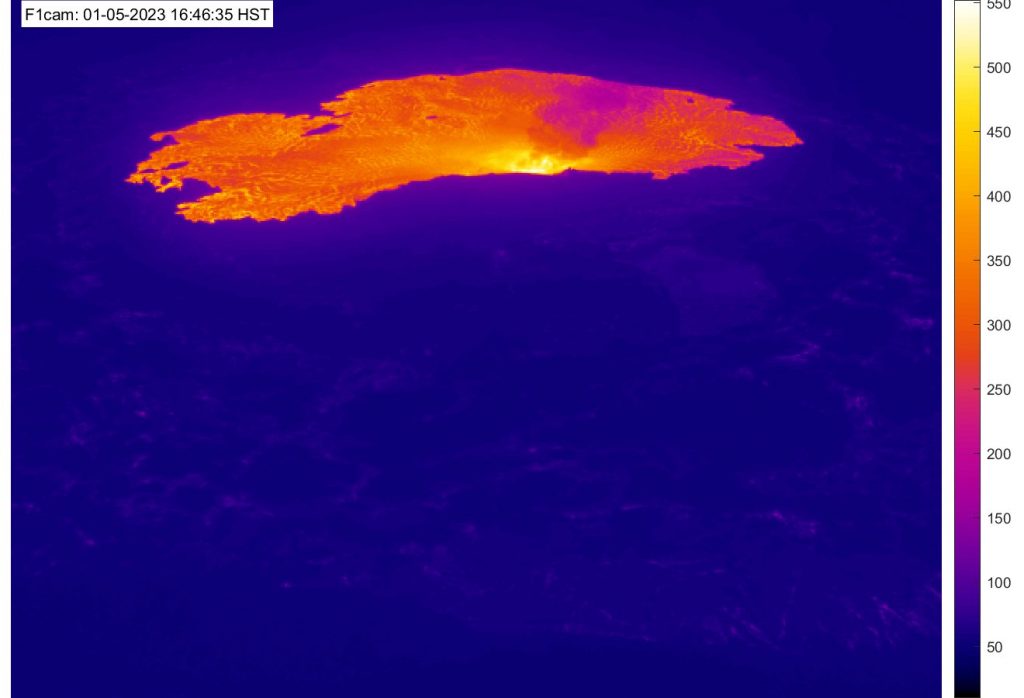Update: Big Island volcano Kīlauea is erupting

Update 8:09 p.m. Jan. 5: Multiple minor fountains are active in the central eastern portion of Halema‘uma‘u crater floor; the largest lava fountain is consistently about 32 feet high. Fountain bursts up to 98 feet high occurred around 7:45 p.m. and there were several bursts up to 164 feet high during the initial part of the eruption.
Lava flows have inundated much of the crater floor, which is nearly 300 acres. As of approximately 7:30 p.m. about 32 feet depth of new lava had been added to the crater floor. Summit tilt switched from inflation to deflation around 5 p.m. Following the eruption onset, summit earthquake activity greatly diminished and eruptive tremor (a signal associated with fluid movement) resumed.
Volcanic gas emissions in the eruption area are elevated. Kīlauea’s volcano alert level and aviation color code will remain at WARNING/RED as this eruption and associated hazards are evaluated overnight.
The color code remains elevated as this hazard can have far-reaching effects down-wind. Hawaiian Volcano Observatory gas specialists are working on quantifying the amount of volcanic gas.
Currently, Hawaiian Volcano Observatory does not see any indication of activity migrating elsewhere on Kīlauea volcano. There is no activity being observed currently outside of the summit region so it’s very unlikely that the lava lake will drain like in 2018 when it erupted in the lower East Rift Zone destroying roads and homes.
The summit eruption of Kīlauea has not had an impact on Mauna Loa. Mauna Loa remains quiet.
Update 4:40 p.m. Jan. 5: Kīlauea volcano is erupting. At approximately 4:34 p.m., the USGS Hawaiian Volcano Observatory detected glow in Kīlauea summit webcam images indicating that the eruption has resumed within Halemaʻumaʻu crater in Kīlauea’s summit caldera, within Hawai‘i Volcanoes National Park.
“There is no threat to communities at this time,” according to the Hawaiʻi Emergency Management Agency.
The observatory has elevated Kīlauea’s volcano alert level from WATCH to WARNING and its aviation color code from ORANGE to RED as this eruption and associated hazards are evaluated.
The opening phases of eruptions are dynamic. Webcam imagery shows fissures at the base of Halemaʻumaʻu crater generating lava flows on the surface of the crater floor. The activity is confined to Halemaʻumaʻu and the hazards will be reassessed as the eruption progresses.
The eruption at Kīlauea’s summit is occurring within a closed area of Hawai’i Volcanoes National Park. Therefore, high levels of volcanic gas are the primary hazard of concern, as this hazard can have far-reaching effects down-wind.
Large amounts of volcanic gas — primarily water vapor (H2O), carbon dioxide (CO2), and sulfur dioxide (SO2) — are continuously released during eruptions of Kīlauea volcano. As SO2 is released from the summit, it will react in the atmosphere to create the visible haze known as vog (volcanic smog) that has been observed downwind of Kīlauea.
Vog creates the potential for airborne health hazards to residents and visitors, damages agricultural crops and other plants, and affects livestock. For more information on gas hazards at the summit of Kīlauea, please see: https://pubs.er.usgs.gov/publication/fs20173017. Vog information can be found at https://vog.ivhhn.org/.
Additional hazards include Pele’s hair and other lightweight volcanic glass fragments from the lava fountains that will fall downwind of the fissure vents and dust the ground within a few hundred yards of the vent (s). Strong winds may waft lighter particles to greater distances. Residents should minimize exposure to these volcanic particles, which can cause skin and eye irritation.
Other significant hazards also remain around Kīlauea caldera from Halemaʻumaʻu crater wall instability, ground cracking and rockfalls that can be enhanced by earthquakes within the area closed to the public. This underscores the extremely hazardous nature of Kīlauea caldera rim surrounding Halemaʻumaʻu crater, an area that has been closed to the public since late 2007.
For discussion of Kīlauea hazards, please see: https://www.usgs.gov/observatories/hawaiian-volcano-observatory/hazards.
Please see the Hawaiʻi Volcanoes National Park website for visitor information: https://www.nps.gov/havo/index.htm.
Visitors to Hawaiʻi Volcanoes National Park should note that under southerly (non-trade) wind conditions, there is potential for a dusting of powdery to gritty ash composed of volcanic glass and rock fragments. These ashfalls represent a minor hazard, but visitors should be aware that such dustings at areas around the Kīlauea summit are possible.
The observatory will continue to monitor this activity closely and report any significant changes in future notices.
The observatory is in constant communication with Hawai‘i Volcanoes National Park as this situation evolves. The activity is confined entirely within the park.
Original post: The Hawaiian Volcano Observatory has raised the volcano alert level/aviation color code for Kīlauea on the Big Island to Watch/Orange.
Kīlauea volcano is not erupting. But the change in the alert level is due to increased earthquake activity and changes in the patterns of ground deformation at Kīlauea’s summit that began occurring in the early morning of Jan. 5.
This indicates movement of magma in the subsurface.
At this time, scientiest at the Hawaiian Volcano Observatory say it is not possible to determine with certainty if this seismic activity will lead to an eruption. The activity may remain below ground.
However, an eruption in Kīlauea’s summit region, within Hawai‘i Volcanoes National Park and away from infrastructure, is one potential outcome.
The observatory will continue to monitor this activity closely and adjust the alert level accordingly.
HVO is in constant communication with Hawai‘i Volcanoes National Park as this situation evolves. The activity is confined entirely within the park.
Sponsored Content
Comments














